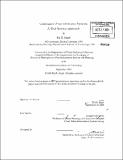Collaborative urban information systems : a Web services approach
Author(s)
Singh, Raj R. (Raj Richard)
DownloadFull printable version (19.15Mb)
Other Contributors
Massachusetts Institute of Technology. Dept. of Urban Studies and Planning.
Advisor
Joseph Ferreira, Jr.
Terms of use
Metadata
Show full item recordAbstract
(cont.) to encourage the interconnection of planning and mainstream information technology. We find that the PAMML framework can lower costs by leveraging mainstream technology, simplify the most basic data sharing activities, yet still allow organizations with different levels of technical sophistication to collaborate. PAMML captures the semantics of spatial planning problems, allowing them to be decomposed into fundamental information processing operations. Regarding user interfaces, we show that PAMML's structure allows multiple end user applications aimed towards different audiences to be easily built from the same core PAMML document. This thesis examines systemic problems with the way information is managed and processed in planning support systems. We find evidence of these problems when we attempt to: develop an analysis without spending most of the time gathering and organizing data sets; or build an analysis that can be re-run at low cost; or implement systems that interact collaboratively with those of other experts. This research starts with the hypothesis that these problems are related and systemic, and that a new paradigm of information management is needed if we can hope to address them effectively. The research is divided into two main sections. First, we develop a theory about how information flows within and across planning organizations, and use the MassGIS buildout analysis to understand how physical planning is done in a cross-jurisdictional, real-world setting. We find that modern organizations do are good at creating and disseminating information, but find it difficult to keep users' copies of published information up-to-date. Furthermore, the technology for building interactive front-ends to analytic models is poorly matched to user needs, and the technology for enabling cross-organization collaborative analysis is non-existent. In the second part of the thesis, we re-architect the information framework, guided by our new theoretical foundation and findings from practice. This new framework is based on Web services, an emerging technology for connecting information systems across organizations. It is called the Planning Analysis and Modeling Markup Language framework, or PAMML, consisting of an information processing vocabulary expressed in XML Schema, Web services based on the schema, and guidance on how to best use the framework
Description
Thesis (Ph. D.)--Massachusetts Institute of Technology, Dept. of Urban Studies and Planning, 2004. Includes bibliographical references (p. 181-186).
Date issued
2004Department
Massachusetts Institute of Technology. Department of Urban Studies and PlanningPublisher
Massachusetts Institute of Technology
Keywords
Urban Studies and Planning.